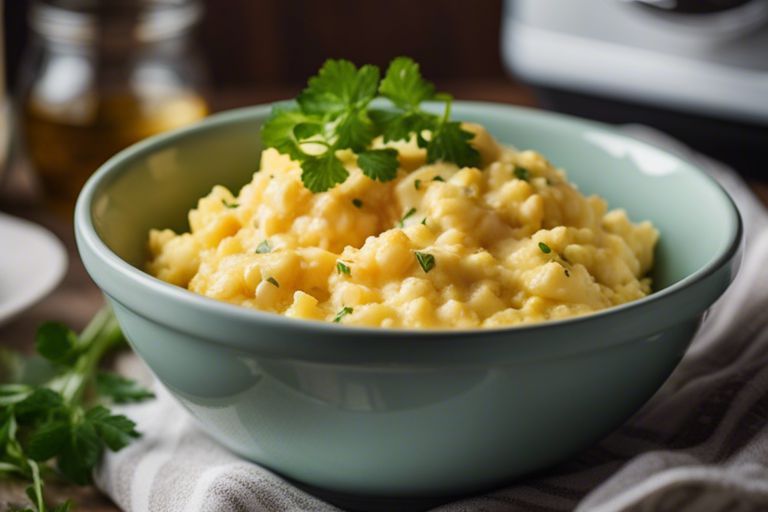Microwaves – the often underestimated kitchen appliance that can actually work wonders when it comes to cooking. But can you really make delicious scrambled eggs in a microwave? In this informative post, we will research into the science behind cooking scrambled eggs in the microwave, debunk myths, and provide you with a foolproof method to achieve perfectly fluffy eggs in minutes. So, grab your eggs and let’s microwave our way to a tasty breakfast!
Key Takeaways:
- Convenience: Cooking scrambled eggs in the microwave is a quick and easy breakfast option for busy mornings.
- Technique: Whisk the eggs in a microwave-safe bowl, season them, and cook in short bursts, stirring in between, for fluffy scrambled eggs.
- Versatility: You can customize your microwave scrambled eggs by adding cheese, vegetables, or herbs for a delicious twist.

The Science of Microwave Cooking
How Microwaves Work
To understand how microwave cooking works, we first need to know a little bit about the science behind microwaves. Microwaves are a form of electromagnetic radiation that causes the water molecules in food to vibrate, generating heat. This heat then cooks the food from the inside out, making it a quick and efficient cooking method.
Cooking Eggs in the Microwave: The Basics
An crucial thing to remember when cooking eggs in the microwave is to use a microwave-safe dish and to cover the eggs while cooking to prevent splattering. To cook scrambled eggs in the microwave, beat the eggs in a microwave-safe bowl, season as desired, and then microwave in short bursts, stirring in between, until the eggs are just set.
Experiment with cooking times and power levels to find the perfect balance for your microwave. Remember that eggs continue to cook even after being removed from the microwave, so it’s better to slightly undercook them than to overcook.
Another tip to keep in mind when cooking eggs in the microwave is to add a splash of milk or cream to the beaten eggs to make them creamier and fluffier. This extra step can elevate your scrambled eggs to a whole new level.
Benefits of Microwave Scrambled Eggs
Time-Saving
Some mornings can be a rush, and finding time to cook a nutritious breakfast can be a challenge. With microwave scrambled eggs, you can have a protein-packed meal ready in minutes. Simply whisk together eggs, milk, and seasonings, pop them in the microwave, and you’ll have a delicious breakfast in no time.
Easy Cleanup
One of the best parts about making scrambled eggs in the microwave is the easy cleanup. No need to scrub multiple pans or deal with stuck-on food. Simply use a microwave-safe bowl, spray it with non-stick cooking spray, and your clean-up will be a breeze.
Easy cleanup means less time spent on washing dishes and more time enjoying your meal and getting on with your day.
Energy Efficiency
With microwave scrambled eggs, you can save energy compared to using a stovetop. Microwaves use less energy than traditional ovens or stovetops, making them a more eco-friendly option for cooking your morning eggs.
For instance, if you’re just making a small portion of scrambled eggs for yourself, using the microwave can be a more efficient choice than heating up a larger stovetop burner.
Debunking Common Concerns
Once again, let’s address some common concerns that arise when considering cooking scrambled eggs in the microwave. It’s important to debunk myths and misconceptions to fully understand this convenient cooking method.
Food Safety: Are Microwave Eggs Safe to Eat?
Food safety is always a valid concern when it comes to cooking. Rest assured, scrambled eggs cooked in the microwave are safe to eat as long as they are cooked thoroughly. Make sure to follow proper guidelines for cooking times and stir the eggs well to ensure even cooking.
Texture and Taste: Will They Be Rubbery or Overcooked?
Will scrambled eggs cooked in the microwave turn out rubbery or overcooked? This is a common concern, but with the right technique, you can achieve fluffy and delicious scrambled eggs. Avoid overcooking by checking the eggs frequently and stirring them well to distribute the heat evenly.
Common mistakes that lead to rubbery eggs include cooking them for too long or at too high power. By adjusting the cooking time and power level, you can ensure that your microwave scrambled eggs turn out perfectly every time.
The Best Microwave Scrambled Egg Recipe
Now let’s examine the best microwave scrambled egg recipe that will give you fluffy and delicious eggs in minutes.
Ingredients and Equipment
To make the best microwave scrambled eggs, you will need eggs, milk, salt, pepper, a microwave-safe bowl, and a fork for whisking. The key to fluffy scrambled eggs is to whisk them well with a splash of milk before cooking.
Cooking Techniques and Timing
Techniques for cooking scrambled eggs in the microwave involve microwaving the whisked eggs in short bursts, stirring in between each burst. This method helps to achieve a creamy and soft texture without overcooking the eggs.
Timing is crucial when cooking scrambled eggs in the microwave. Start by microwaving the eggs for 30 seconds, then stir, and continue to cook in 15-second increments until the eggs are just set. Be careful not to overcook the eggs as they can become rubbery.
This cooking method is quick and convenient, making it perfect for busy mornings or when you want a protein-packed snack.
Tips for Customization
The beauty of microwave scrambled eggs is that you can customize them to your liking. Add in ingredients like cheese, chopped herbs, diced vegetables, or cooked meats to elevate the flavor of your eggs. Experiment with different seasonings to suit your taste preferences.
- Try adding a sprinkle of smoked paprika for a smoky flavor.
- Top your scrambled eggs with a dollop of salsa for a zesty kick.
The possibilities are endless when it comes to customizing your microwave scrambled eggs to create a delicious and satisfying meal.
Ingredients
The base ingredients for microwave scrambled eggs include eggs, milk, salt, and pepper. These simple ingredients can be enhanced with additional toppings and seasonings to elevate the flavor of the dish.
Common Mistakes to Avoid
Overcooking and Undercooking
All too often, microwave scrambled eggs can end up either overcooked and rubbery or undercooked and runny. The key is to find the right balance to achieve perfectly fluffy eggs. Remember that the eggs will continue to cook even after you take them out of the microwave, so it’s necessary to factor in this residual heat.
Not Whisking the Eggs Properly
To create light and airy scrambled eggs, proper whisking is crucial. Be sure to thoroughly whisk the eggs until the yolks and whites are completely blended. This process helps incorporate air into the eggs, resulting in a fluffier texture. Skipping this step can lead to denser and less appealing scrambled eggs.
To ensure the eggs are well whisked, use a fork or whisk and beat the eggs until a consistent mixture is achieved. Pay attention to the color and texture, aiming for a uniform yellow with no streaks of egg white visible.
Not Using the Right Container
Using the wrong container can also affect the outcome of your microwave scrambled eggs. Avoid using metal or plastic containers that are not microwave-safe, as they can cause uneven cooking and even pose safety hazards. Opt for a microwave-safe bowl or dish to ensure a more even and controlled cooking process.
Plus, using a larger container than necessary can lead to overcooking the edges while the center remains undercooked. Choose a container that allows the eggs to spread out slightly but is not overly large for the amount of eggs you are cooking.

Variations and Add-Ins
Adding Vegetables and Herbs
On top of the basic scrambled egg recipe, you can level up your microwave scrambled eggs by incorporating various vegetables and herbs. Adding diced bell peppers, onions, spinach, and tomatoes can not only enhance the flavor but also boost the nutritional value of your meal. Herbs like chives, parsley, or basil can bring a fresh and aromatic touch to your eggs.
Using Different Types of Eggs
Herbs such as chives, parsley, or basil can bring a fresh and aromatic touch to your eggs. Different types of eggs like duck or quail eggs can be used to create unique and interesting scrambled egg dishes. Duck eggs have a richer flavor and a higher fat content, resulting in creamier scrambled eggs, while quail eggs are smaller and can add a novelty factor to your dish.
|
|
Spicy and Smoky Variations
With a few additions, you can transform your basic microwave scrambled eggs into a spicy or smoky treat. Adding ingredients like diced jalapeños, red pepper flakes, or hot sauce can give your eggs a kick of heat. Alternatively, you can introduce smoky flavors by mixing in ingredients such as smoked paprika, chipotle peppers, or even crumbled bacon.
Variations:
Conclusion
Upon reflecting on the possibility of cooking scrambled eggs in the microwave, it becomes clear that while it is indeed feasible, the end result may not be as fluffy and creamy as traditional stovetop methods. The convenience and speed of microwaving scrambled eggs may appeal to those with limited time or kitchen resources, but the taste and texture may not be up to par with the classic method.
Conclusively, while yes, you can cook scrambled eggs in the microwave, it may not produce the same quality dish as cooking them on the stove. The choice ultimately comes down to personal preference and convenience, but for those seeking the best possible scrambled eggs, sticking to the stovetop method may be the way to go.
FAQ
Q: Can you cook scrambled eggs in the microwave?
A: Yes, you can definitely cook scrambled eggs in the microwave! It’s a quick and easy way to whip up a tasty breakfast in no time.
Q: What do I need to make scrambled eggs in the microwave?
A: All you need is a microwave-safe bowl, eggs, milk, salt, pepper, and any additional ingredients you want to add, such as cheese, veggies, or herbs.
Q: How do I cook scrambled eggs in the microwave?
A: Simply beat the eggs with milk, salt, and pepper in a microwave-safe bowl, stir in any additional ingredients, and microwave in short intervals, stirring in between until the eggs are cooked to your liking.
Q: Are there any tips for cooking scrambled eggs in the microwave?
A: Yes, make sure to use a large enough bowl to prevent overflow, stir the eggs well to ensure even cooking, and don’t overcook them to avoid a rubbery texture.
Q: How long does it take to cook scrambled eggs in the microwave?
A: Cooking time can vary depending on your microwave’s wattage and how many eggs you’re cooking, but typically it takes around 1-2 minutes for 2 eggs. Keep an eye on them and adjust the time as needed.
